Best Exercise Bikes for Home 2022

Investing in the best exercise bike is a great way to meet your fitness goals from home – and means you won’t have to compete with busy traffic or bad weather.
The first thing to consider when choosing between different exercise bikes is price. What’s your budget? The more you have to spend, the more feature-rich and high tech your machine will be. Cheaper exercise bikes often tend not to have screens, so if you want to save money and use a smartphone or tablet to stream virtual classes or free YouTube workouts, then this could be a good option.
Next, think about space. Some bikes have a large footprint, so check out the dimensions before you make a purchase. Thirdly, what kind of pedals do you prefer? Many exercise bikes come with dual pedals – SPD compatible (clip ins) and toe cage. Clip in pedals require cycling shoes (opens in new tab), so you’ll want to know about the best shoes for Peloton (opens in new tab) to help you make an informed decision.
Best exercise bikes
Stylish and feature-rich, the Peloton Bike is a bestseller for good reason. It’s not cheap, but what you get for your dollar is an extremely well-made machine with endless features to keep you motivated and on track with your health and fitness goals.
It comes in Peloton’s signature black and red colors, and has a small footprint making it a good choice for people short on space. It’s also ergonomic so it feels comfortable and smooth to ride. Just bear in mind that the pedals require specific Look Delta cleat-compatible shoes, which is an extra cost on top of the bike.
The original Peloton Bike has a crisp touchscreen with all of its features hidden within the monitor — this is deliberate so that the bike itself isn’t cluttered by lots of buttons. With daily live workouts and on-demand classes via the Peloton app, one of the big draws of this bike is that you will never get bored as there is so much virtual content. A subscription is, however, needed to access the app. If you branch out and buy another Peloton product like the Peloton Tread, you can use your existing app subscription to access running content too. Another big pull is the bike is quiet and intuitive to use. Overall, the Peloton Bike offers one of the most satisfying riding experiences out there.

The Yosuda indoor cycling bike is a great value exercise bike for people on a budget who want a spinning style workout. It is well-made and sturdy, with a simple design that makes it intuitive to use, and has a friction resistance on the flywheel that is fairly quiet and smooth. It’s this slightly lower tech system that also makes the bike more affordable.
There is no touchscreen or monitor and the computer display is very basic, but it shows all the core metrics you need, including time, speed, distance and calories. The Yosuda exercise bike doesn’t have any programmed classes either, but you can get around this by simply watching a free Youtube workout on your phone or tablet, or using another app like iFit or Peloton to access live or on-demand online classes.
One big perk is the way the handlebars angle in – this really helps when leaning forward in racing style rides, as it’s a more comfortable and natural position for the shoulders and arms. The bike has dual pedals – cage and clip in – so you don’t have to buy expensive cycling shoes to use the machine unless you want to.
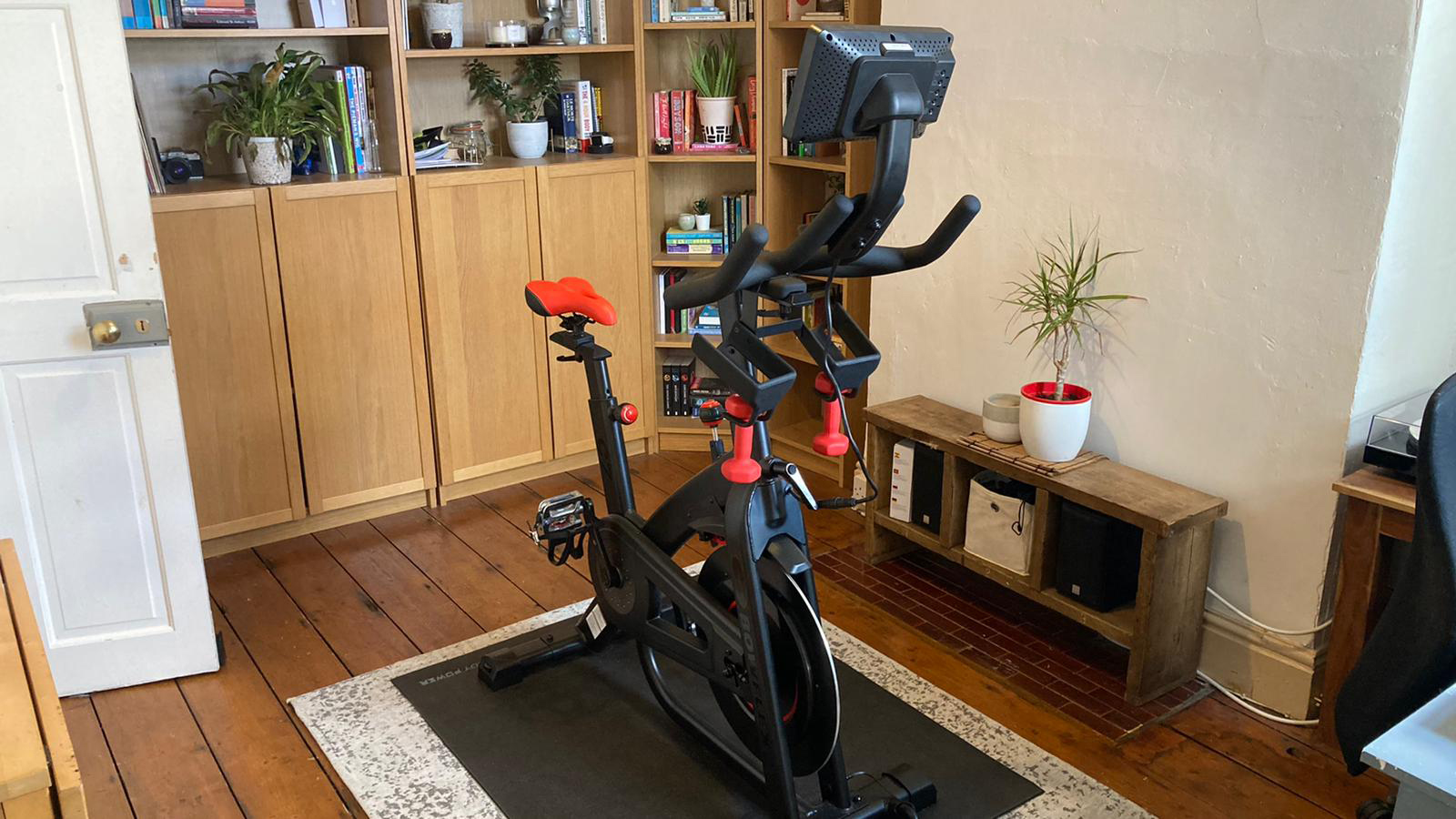
The Bowflex C7 Bike is a top Peloton alternative. It’s cheaper than the chart-topping exercise bike, has a 40lb flywheel that offers a smooth, silent ride, and allows you to connect to the Peloton app for some workouts – as well as Zwift, Bowflex’s own JRNY platform and more.
These are welcome options to have, but if you’re keen to save on monthly membership fees you can enjoy 12 months free access to Bowflex’s JRNY app. This has an impressive array of interval workouts available, including virtual rides in scenic locations around the world, studio classes and interval sessions. These can be viewed via the vibrant, responsive 7in touchscreen, or you can complete off-bike classes like strength training, yoga and Pilates while streaming the app on your phone or tablet – a feature we loved when we tried it out.
The screen is on the smaller side, and cross-training workouts that combine bike work with off-bike exercises or stretching faltered as the classes automatically paused when the pedals weren’t moving for a few seconds. But those were the only faults we found with this quality machine, which boasts all the markings of a premium product at a more modest price point.
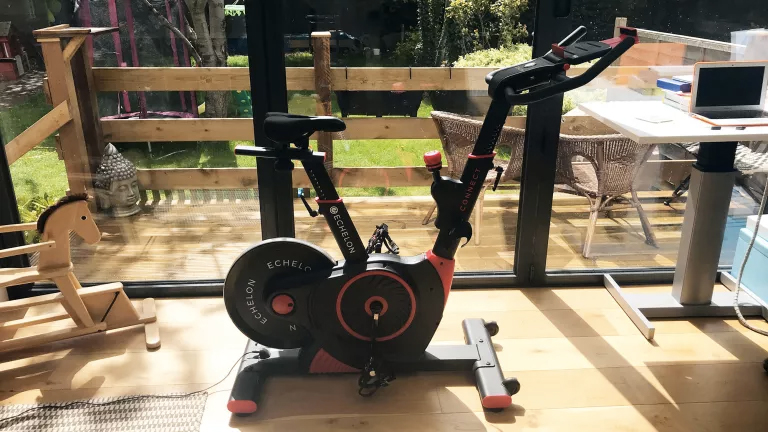
The Echelon Connect EX3 is a good-looking and cost-effective Peloton alternative, which offers a smooth riding experience and motivating workouts and challenges (via the Echelon app, for which a subscription is needed). The bike itself looks similar to something you’d find in a spin class, and it’s compact and well designed. It also has a max weight capacity of 136kg so is suitable for heavier users.
Unlike a Peloton it doesn’t have a built-in screen, but it has space for a tablet or phone where you can watch free online workouts or classes on the Echelon app – filtered by workout type, music, instructor and duration. Alternatively, you can use another third-party app to access virtual classes.
The Echelon Connect EX3 is fully integrated and connects with Bluetooth so you can track your stats in real-time. You can also connect it to Facebook to share your workout or compete with friends and family. The magnetic resistance dial, while quiet and smooth, is a little under-sensitive, but nothing that should get in your way. This is an impressive indoor cycling machine that is intuitive to use and a solid investment for both beginners and seasoned riders.
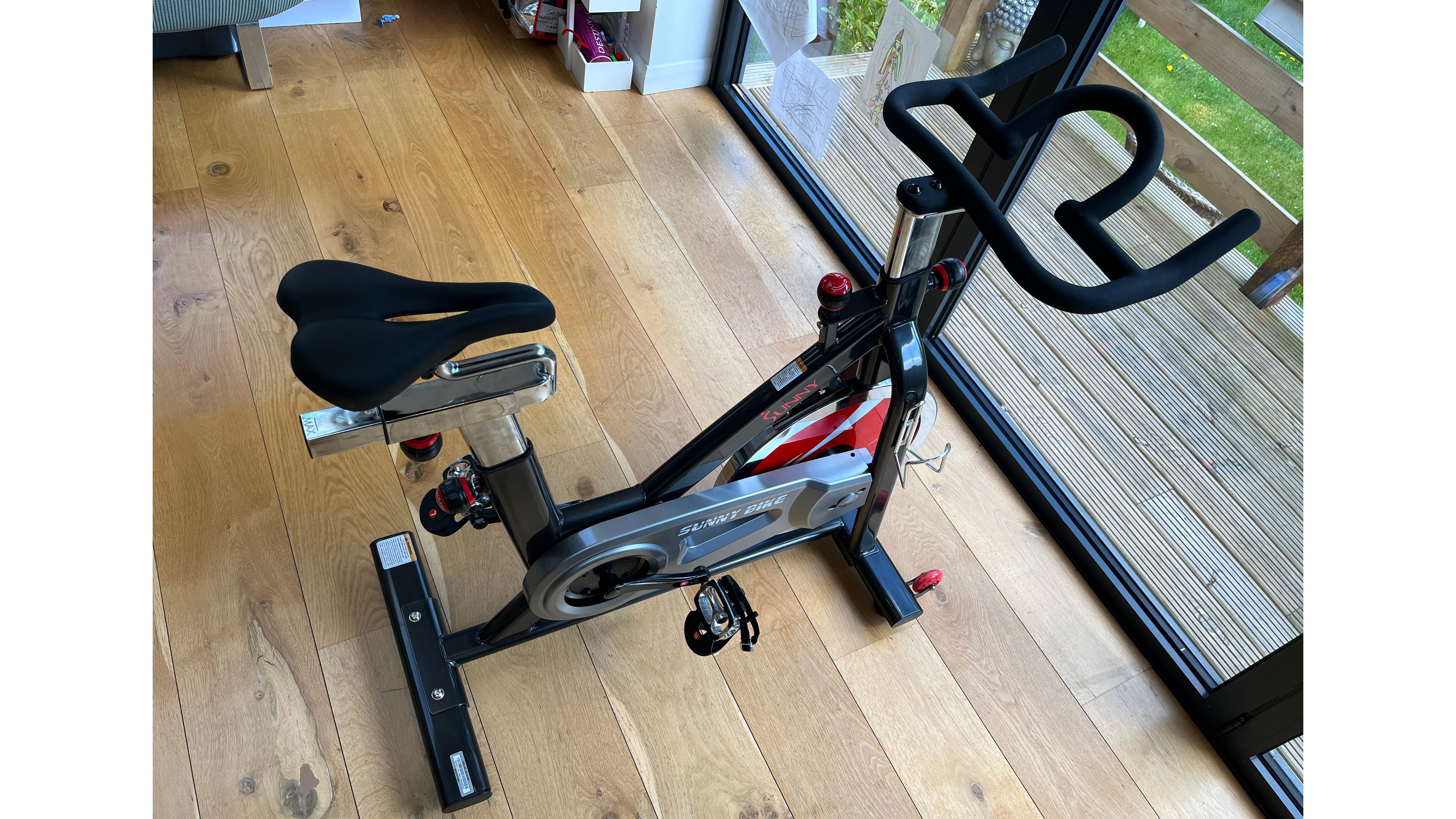
If you’re after a basic indoor cycling experience without breaking the bank, then the Sunny Health & Fitness Indoor Cycle Bike is a solid option. It’s pretty compact, and has the look and feel of a gym-style spin bike with a good resistance range on the flywheel. The resistance goes up to 100, which is more than enough for a challenging workout, and it moves smoothly between gears with minimal noise.
You’ll need to pay for a subscription to access the virtual content on the Sunny Health & Fitness app, but you can use the bike without it. It’s also budget-friendly, so if you’re not sure how much you’re going to use it, this might be a good option for you.
We love how quiet it is, which is a bonus for anyone living in shared accommodation or an apartment. A drawback is the seat can be a little uncomfortable, but after a few weeks of ‘breaking it in’, it’s easier to ride on. There’s no way of tracking cadence (the speed you’re pedaling) so it’s hard to monitor intensity, but if you want to test-run an indoor bike without spending too much, then the Sunny Health & Fitness Indoor Cycle Bike is a no-frills choice.
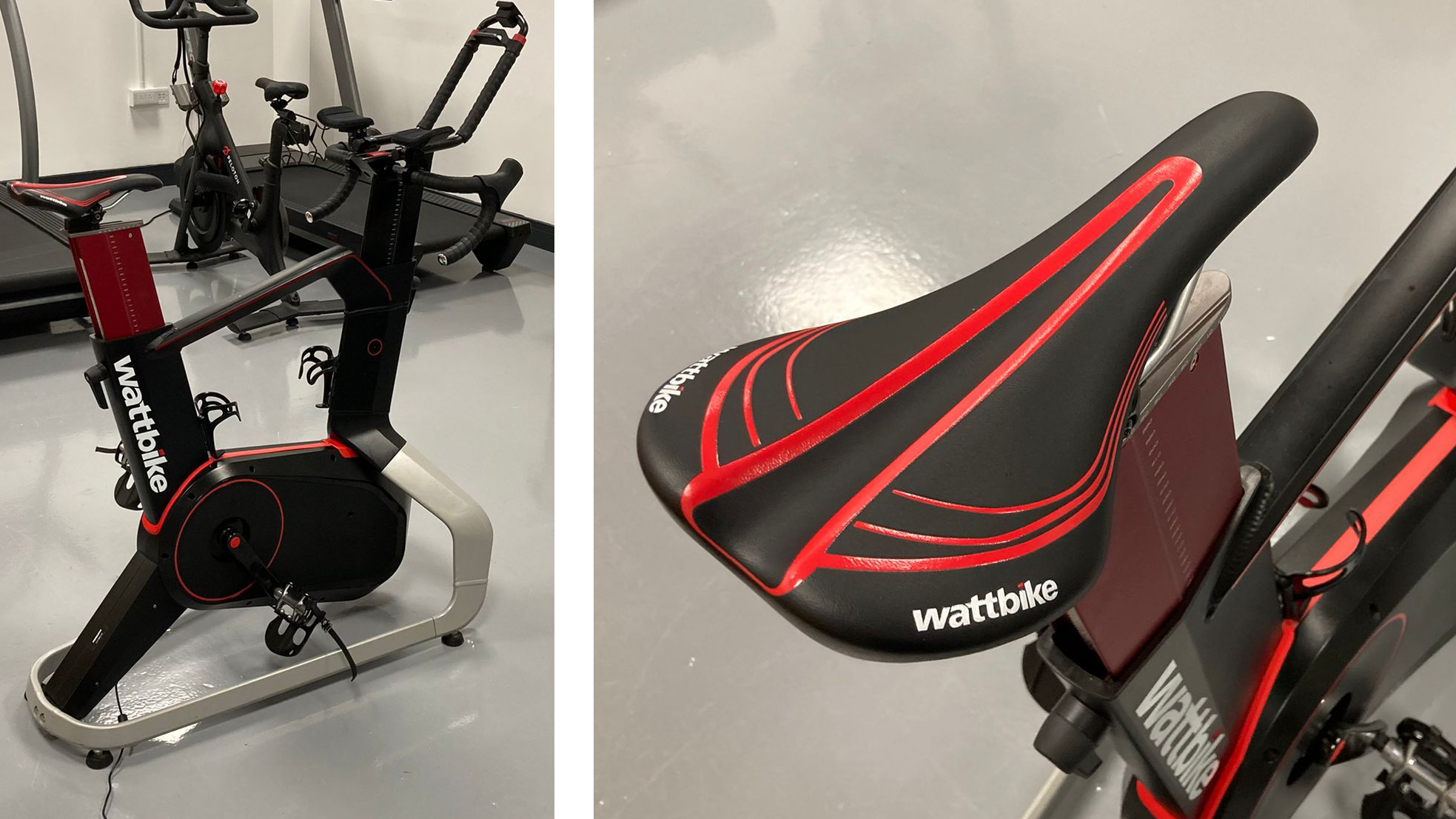
This is a competitively priced and high quality machine for anyone looking for an all-rounder exercise bike. It’s well made, with a ton of features that will appeal to both data-hungry athletes and people new to indoor cycling. Make no mistake, this is a big machine, and you’ll need a lot of space to house it. Whilst it’s 11kg lighter than its predecessor the Wattbike Pro, at 44kg it’s still a bit of a beast so you’ll need to find a good location for it before setting it up.
The Wattbike offers a smooth and realistic ride, thanks to its new electromagnetic resistance and impressive range through 22 gears. It has auto-resistance that automatically adjusts to simulate different terrains and inclines, making for a more intense workout. As well as the Wattbike Hub app, it syncs nicely with other fitness apps including Zwift.
It doesn’t have a built-in monitor and lacks a USB port to charge your smartphone or tablet, which is a bit frustrating considering this is likely to be your main way of following online workouts. It’s also not compatible with Apple Watch or Fitbit, which is a shame for the high price, but overall this is a well-made and feature-rich exercise bike that delivers on design and functionality.
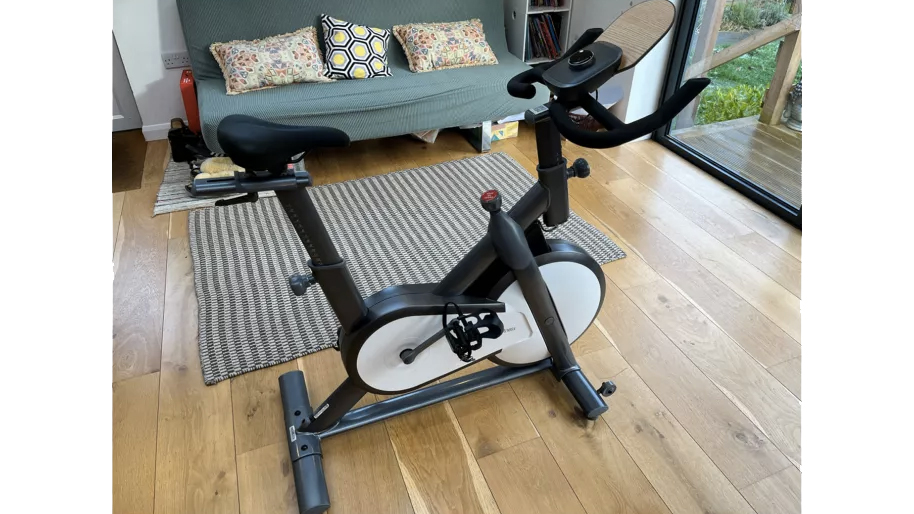
Good value and streamline, the Mobi Turbo Exercise Bike is a great starter machine for spinning fans on a budget. It is fast to assemble and compact with a small footprint, so it’s suitable for people short on space.
Despite it’s low price it has an efficient auto-resistance feature, automatically adjusting the intensity during workouts to simulate real terrains. This helps to create a more realistic riding experience, and also keeps you from ‘coasting’ or not pushing yourself during a class. However, you can also adjust the resistance via the dial or on the free app if you prefer.
Instead of a touchscreen, the Mobi Turbo exercise bike has a LCD control screen. It’s lacking a water bottle holder, which is frustrating, and the app has very limited workouts – although more content is promised soon. If you have a Peloton or iFit membership you could use these to follow workouts on the bike instead.
This is a no-frills, spinning style bike for people who don’t need a ton of features or virtual classes to keep them motivated. It’s not the prettiest of machines and it’s lacking in functionality, but it has an ergonomic design and a big padded seat that makes riding more comfortable.
How we test exercise bikes
We subjected all bikes to a rigorous review process, working through the gears to make sure they were able to deliver a lung-busting workout.
Our testing team completed a range of workouts, including an active recovery session, an intense interval workout, and a longer endurance piece, before scoring each exercise bike on five factors:
- Set up and usability
- Design and display
- Features
- Performance
- Value for money
Results were used to calculate a final score out of five and inform a detailed verdict designed to summarize each exercise bike’s strengths and weaknesses, helping you pick the best product for you.
Exercise bike vs other kinds of exercise
We spoke to physiotherapist and bike fit expert Sam Birch to find out why cycling is so popular. He told us that cycling is a brilliant way for those recovering from lower-limb injuries to still achieve a cardio workout, without the impact.
Cycling is considered more of a lower body workout, but your upper body provides stabilization, and you can still improve your cardio and ramp up calorie burn.

Currently a Specialist Musculoskeletal Physiotherapist at Pure Sports Medicine (opens in new tab), Birch has a keen interest in post-surgical rehabilitation, cycling injuries and sports rehabilitation.
Exercise bike vs treadmill
So why jump on one of the best treadmills (opens in new tab) instead of a bike?
Treadmills are arguably more versatile, though many bikes are now souped up with similar specs. Both allow you to focus on aerobic exercise (opens in new tab) (like jogging or gentle cycling, using oxygen) and anaerobic exercise (opens in new tab) (like sprinting or high-intensity spin, without using oxygen). Both also come packed with benefits like improved cardio fitness, stronger muscles, and healthier bones though they target your muscles differently.
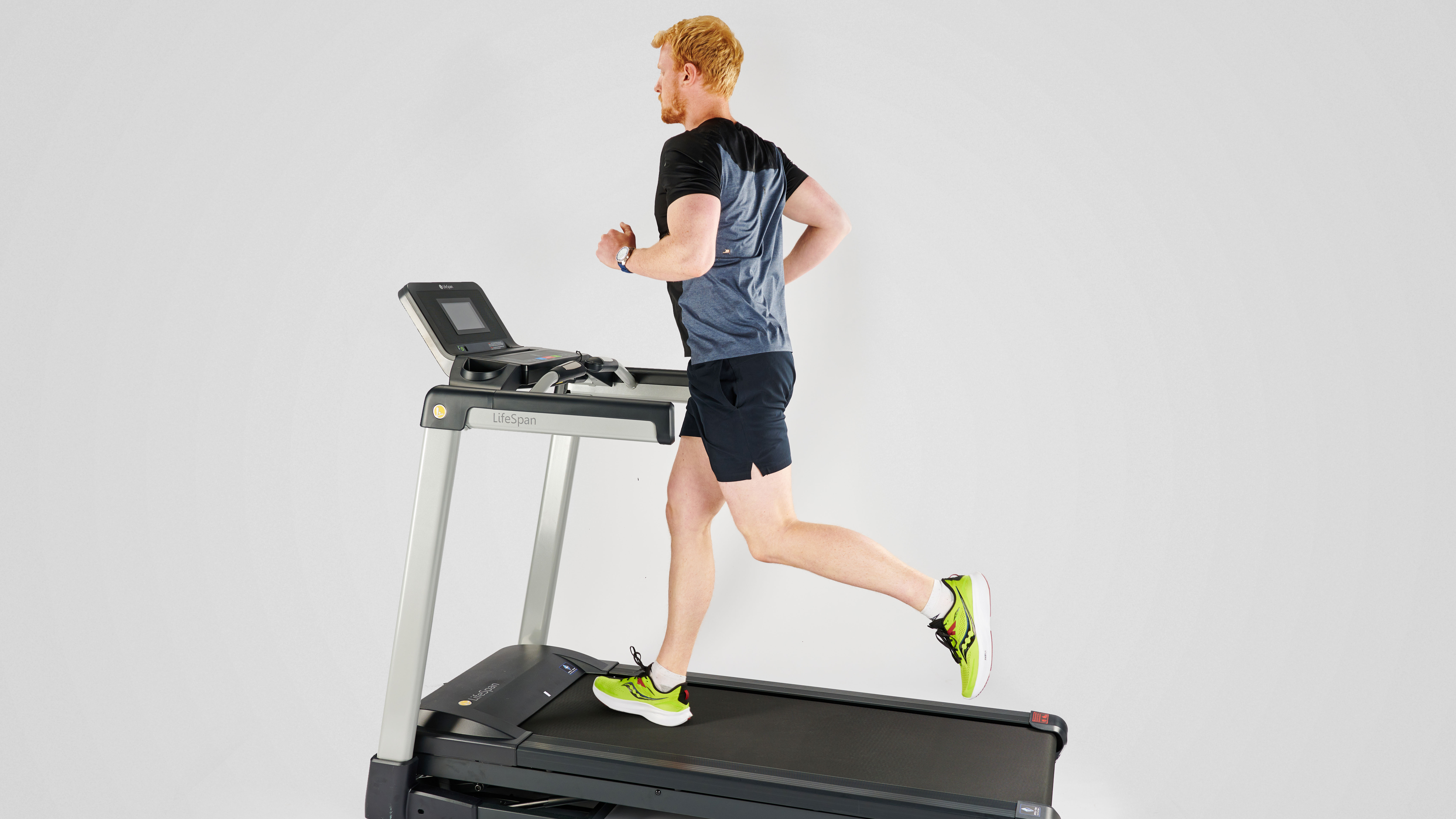
Running (opens in new tab)is a full-body workout, engaging your upper and lower body to achieve forward propulsion. A study published in the Journal of the American College of Cardiology (opens in new tab) found that even small regular increments of running can reduce the risk of developing chronic cardiovascular diseases.
The downside for keen runners is the impact on joints, even if you run on shock-absorbing tread belts. Learning how to run properly (opens in new tab) and how running shoes should fit (opens in new tab) are two ways to tackle it, but exercise bikes mitigate the risks of joint injuries.
Exercise bikes and treadmills are on an even keel for price, size, and workout experience, and exercise bikes are far more sophisticated than they used to be. Immersive color screens, live and on-demand classes and a vast range of workout options are available on both, so really it comes down to personal preference and whether you want to focus on full-body training.
Recumbent exercise bike vs upright bikes
If you’ve been to the gym and mistaken an exercise bike for a go-kart, you’ve seen a recumbent bike. Recumbent bikes sit close to the floor in a reclined position and house front pedals, whereas upright bikes look like spin bikes.
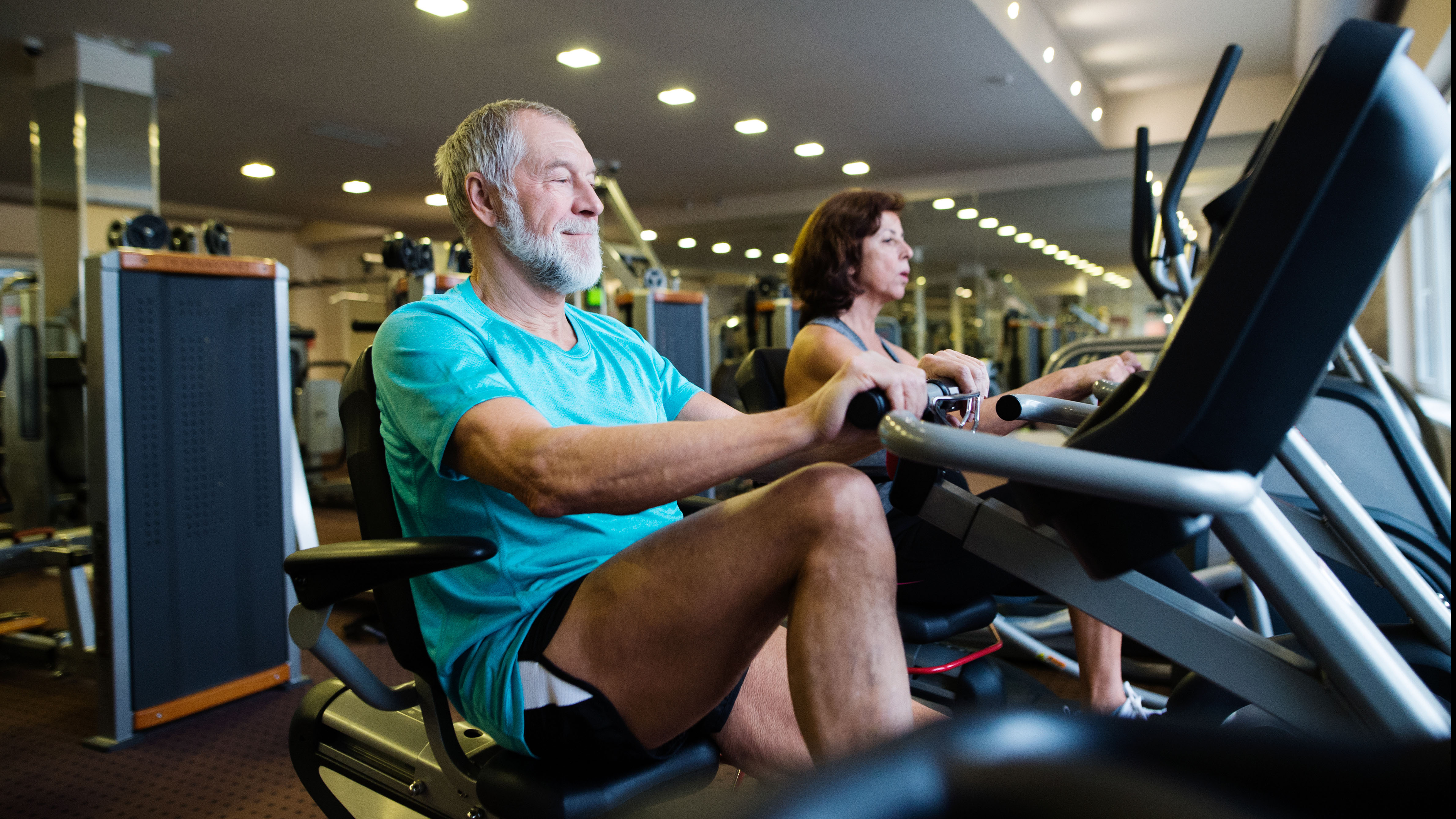
Recumbent bikes didn’t make it into our round-up this time, but that doesn’t mean they’re not useful. These models are an ergonomic solution because the front pedal position helps to redistribute your weight which places less pressure on your knees and tailbone, and they also have a backrest.
Spine Health (opens in new tab) found that rough terrain and poor posture increase pressure on your lower back and could cause injury, so a reclined recumbent bike could help if you’re recovering from injury or new to exercise.
However, this positioning could result in a lack of core, glute, and upper body engagement, as sitting upright requires more core and upper body engagement for stabilization.
Birch says that the type of exercise bike you choose is up to you. “Personally, I find upright bikes better replicate an actual cycling position,” he tells us. “There’s also better leg muscle recruitment which allows maximal power output when pedaling.” He also believes that recumbent exercise bikes are more supportive, but they offer an unnatural cycling experience, and it’s harder to put power through the pedals.
The reduced drag is said to produce faster speeds which technically makes them more aerodynamic. However, a study published in Frontiers in Sport and Active Living (opens in new tab) found power output higher in upright bikes, and Birch agrees.
Exercise bike vs rowing machine
Which machine wins between rowing vs cycling (opens in new tab)? Well, neither are as high-impact as running, so you could feel prepped to exercise for longer. Both also work the aerobic and anaerobic systems (if you decide to include HIIT), meaning cardio gains and improvements in power, strength, and endurance are up for grabs, too (as mentioned above).
The main difference is the muscles worked. Rowing targets roughly 86% of muscles in the body, offering a more full-body strength workout than cycling. It depends somewhat on how you train though, as outdoor cyclists who tackle tricky terrain will likely use more of their core than indoor cyclists.
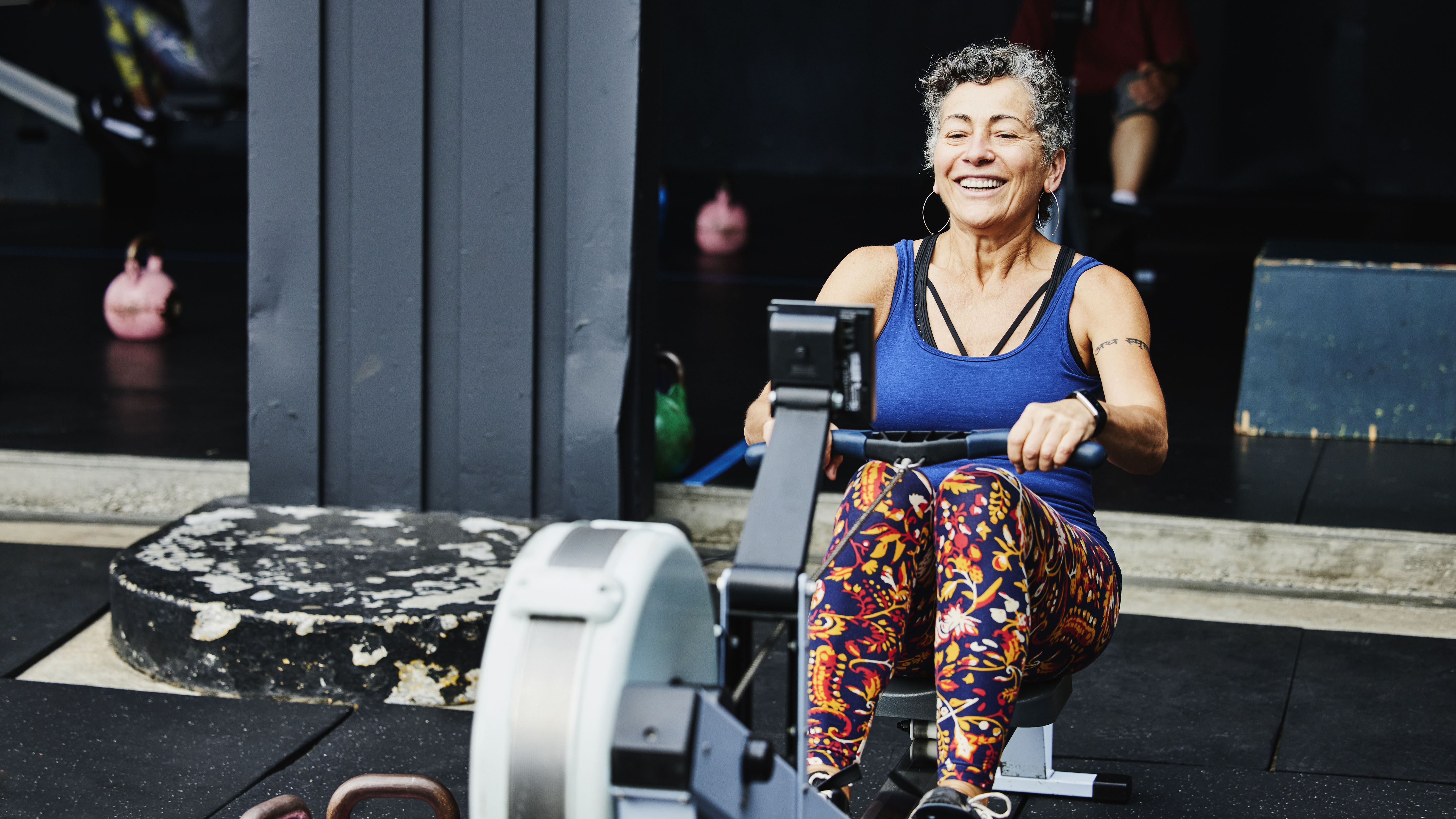
Rowing machine benefits (opens in new tab) are plentiful, including stronger bones and muscles, but calorie burn is more unclear and depends on personal parameters like weight, speed, and distance. One calorie calculator (opens in new tab) based on the compendium of physical activities values (opens in new tab) (a value system used globally to quantify energy cost) averaged calorie burn somewhere between 500-700 per hour rowing at 100 watts and 400-800 calories per hour cycling.
However, Harvard Medical School (opens in new tab) estimated calorie burn for a 155lb person after 30 minutes of moderate cycling and rowing to be the same, but rowing took victory during high-intensity training. In short? Both offer similar benefits, but although cycling is more accessible, rowing provides more of a full-body resistance workout.
Exercise bike vs air bikes
Different types of exercise bikes (opens in new tab) offer different experiences.
An exercise bike that has crept into gyms, workout classes, and social media videos worldwide is the air dyne, also referred to as an air bike or assault bike. The name says it all.
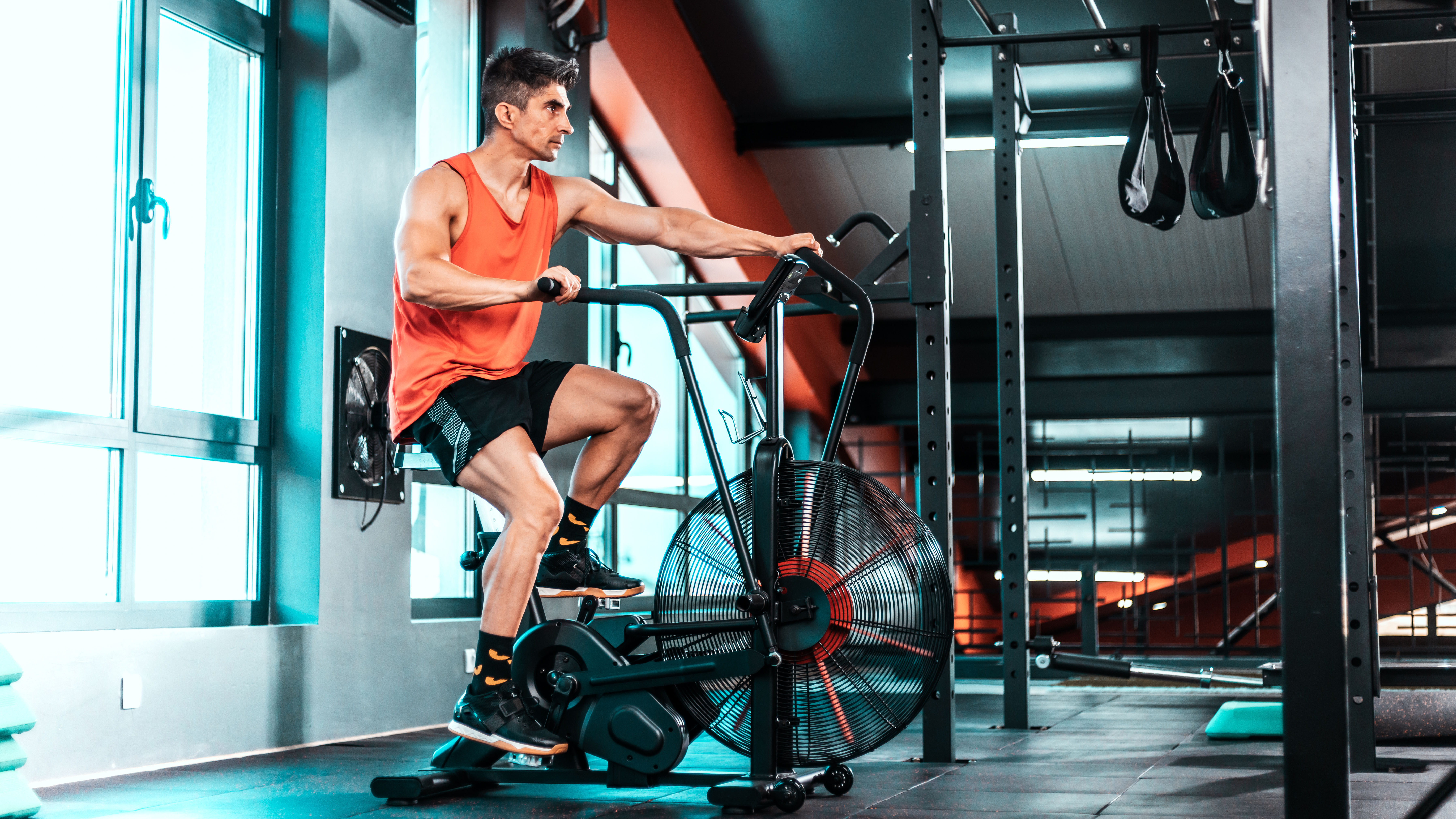
Air bikes are still low-impact and seated, but they house moving handles (similar to a cross trainer) that work alongside the pedals and require your arms to push and pull to drive movement.
The aim is to add resistance and increase muscular engagement using a fan on the front wheel. Typically, they’re used (and feared) as a metabolic conditioning tool, helping to ramp up calorie burn, build strength, and improve endurance by engaging your full body to ‘overcome’ resistance on the handles and pedal.
Benefits remain similar to regular cycling, but you’re more likely to find this kit in HIIT classes and functional training, usually paired with free weights and bodyweight cardio like burpees.
The front wheel offers up to 10 resistance levels for all abilities, similar to a spin bike, but resistance is set on the wheel itself.
A study published in the International Journal of Exercise Science (opens in new tab) incorporated 1-minute assault bike rounds into a high-intensity functional training class and included an upper and lower body ergometer. Compared with leg pedaling alone, the upper-body ergometer provided additional muscle mass, stress to the cardiovascular system, and increased heart rate. This could also explain the higher metabolic costs.
Exercise bike vs elliptical
Both are low-impact, but ellipticals (also called cross trainers) engage the upper and lower body together for a full-body workout. Using an elliptical feels more like running though, so while it could be a safe alternative for runners, it’s unlikely that cyclists would favor them.

Elliptical machines house oversized foot pedals and large handles for your hands, which allows you to mimic a running stride. As with running, your upper and lower body work together, but the added resistance increases intensity. You can still achieve a HIIT workout using these machines, similar to cycling, and the benefits are also similar.
According to one study published in the National Institutes of Health (opens in new tab), ellipticals encouraged greater engagement in the quadriceps and quadriceps-hamstrings coactivation than walking and stationary cycling.
Exercise bikes are handier for saving space (especially folding designs), particularly if you live in a city apartment, but considering Harvard Medical School reckons a 155lb person could ramp up around 324 calories in 30 minutes – it could be worth making room.
What should I look for in an exercise bike?
The best exercise bikes have a mix of clever design, awesome features and motivating classes.
A bigger budget generally equals a feature-rich exercise bike, but if you’re new to fitness this may not be a priority for you. In fact you can save money by opting for a bike that doesn’t come with a screen, and just use your smartphone or tablet to stream virtual classes.
The size of the exercise bike is worth considering, so think about floor space before making a big investment, especially if you live in shared accommodation. If you’re particularly tall or short, check if you can adjust the seat and handlebar height. Cheaper exercise bikes also tend to have a lower weight limit, so it may be worth taking note of the max weight if you think this will be a concern.
Noise levels are also worth considering – read the best exercise bike reviews to see how loud they are.
If you are someone that likes a group class setting, you’ll probably want to choose an exercise bike that works with an app to stream online classes, like Peloton or iFit (subscription needed). Remember that you can still use these apps with your phone or tablet on cheaper exercise bikes – you just won’t be able to sync your metrics.
Finally consider the pedal type – toe cage ones work with normal sneakers, whereas clip in ones require special cycling shoes. Many exercise bikes have dual pedals, which are interchangeable.
So are you ready to take the next step towards achieving your fitness goals? Once you’ve chosen your perfect machine, make sure you read our handy guide on how to get the most out of your exercise bike (opens in new tab).
Is an exercise bike as good as cycling?
Birch tells us that exercise bikes offer consistent resistance over a set period, whereas outdoor cycling could mean contending with stop signals, traffic, or cruisey downhill routes.
However, while this is beneficial for specific training methods or monitoring your power output during HIIT bike workouts (opens in new tab), it can feel boring. Birch says that getting fresh air and cycling with friends might be a more pleasurable experience.
Regardless, both methods can improve your cardio and get those glutes firing up, and most of the intensity of outdoor training can be matched on more advanced indoor spin bikes.
The Journal of Exercise Rehabilitation (opens in new tab) studied a spinning group and a standard cycling group to see what (if any) differences there are. Somewhat surprisingly, the spinning group results were greater for improved body composition and fitness, although both groups saw positive changes across all health parameters.
Although variables like weight, distance, and intensity will affect your results, spin classes might encourage the adherence and motivation lacking for some solo cyclists. Instructors may also have you pushing harder on those pedals when your head is telling you a firm ‘no.’
That isn’t to say outdoor cycling doesn’t offer its own set of unique perks. A study into the effects of outdoor cycling on people suffering from mental illness found that factors like community and fresh air could empower people and promote long-term physical activity – as published in the International Journal of Environmental Research and Public Health. (opens in new tab)
What is the most comfortable exercise bike?
Birch recommends the Wattbike because of its realistic bike geometry, saying it’s easy to adjust and replicates a regular bike setup without the cramped feeling of upright bikes (like Peloton and Echelon). “Their lack of adjustability makes people feel they’re stretching for the handlebars,” he says. And there isn’t much you can do to combat this.
Personally, we loved the affordable Yosuda Indoor Stationary Cycling Bike (opens in new tab), which has the comfiest seat we’ve tested – something you’ll come to cherish if you’re buying your first bike, trust us. We found the Peloton bike too solid and kept adjusting mid-workout to find a comfier position (we didn’t find one).
If you’re recovering from injury, new to exercise or have long-term lower back or knee issues, a recumbent bike could provide far more support, although you’d need the space to house it.
Keen to follow Birch and try the Wattbike? Our Wattbike Atom review (opens in new tab) can advise you on what to expect. All in all, it depends on your preferences, fitness goals, and home living situation.
Is an exercise bike good for losing weight?
If you’re questioning – Are exercise bikes good for weight loss? (opens in new tab) We asked Birch his thoughts.
He tells us that exercise (in general) contributes toward weight loss, but a weight loss journey consists of a whole lot more, including your diet. And poor diet can’t be out-cycled.
Instead, Birch advises a calorie deficit (opens in new tab) alongside your training if you’re aiming to lose weight.
Cycling does burn calories, but this shouldn’t pull focus from its ability to boost your cardio fitness and overall health. That said, exercise bikes still make it into our best exercise machines to lose weight (opens in new tab) guide.
Wondering how to ramp up calorie burn? A study published in the International Journal of Sports Nutrition and Exercise Metabolism (opens in new tab) measured excess post-exercise oxygen consumption (EPOC) in 12 men engaging in interval training and continuous cycling. EPOC refers to the increase in oxygen consumption after high-intensity exercise, resulting in a temporary rise in metabolism and calorie burn as we return to homeostasis – ‘normal.’
Results were similar when the total workload was similar, but the heart rate was higher during interval training. While pedaling against resistance, muscles are forced to work harder, increasing heart rate, respiration, and calorie burn.
Meanwhile, a study published in the Journal of Exercise Rehabilitation (opens in new tab) studied 24 female middle school students for 16 weeks cycling for one hour a day, three times a week, and compared spinning groups with regular cycling. Results showed improvements for both, with significant changes in the spinning group – especially in body fat percentage and body mass.
Controlling speed and resistance can help you tap into aerobic, anaerobic, and strength training systems. Of course, a myriad of factors like diet, hormones, and lifestyle play a part, too.
So, do exercise bikes burn belly fat? (opens in new tab) While aerobic training can optimize fat burn (read the best time to workout (opens in new tab) to find out why), unfortunately, you can’t ‘spot reduce’ fat.
What are the benefits of riding a stationary bike every day?
The Journal of the American Heart Association (opens in new tab) found cycling to lower the risk of chronic cardiovascular disease and Spine Health (opens in new tab) encourages cycling as a gentle way to achieve high-intensity exercise. We’ve already mentioned most of the benefits, but discovering how to get the most out of your exercise bike (opens in new tab) can help you hit your goals more efficiently.
Your glutes, quads, hamstrings, and core benefit most from cycling (alongside your heart and lungs), but physiotherapist Birch says consistency is the key. He recommends daily cycling if you want to improve because this progressively loads and trains those muscle groups. “You will notice increased leg strength and improved cardio fitness, too,” he says.
However, Birch recommends adding variation to keep it interesting. After all, variety is the spice of life.
Although you might be concerned about which muscles are used in cycling (opens in new tab), a well-crafted program includes weight training (opens in new tab) and increasing your daily movement (NEAT (opens in new tab)).
Which is better: Peloton vs Echelon?
We recommend checking out our Peloton vs Echelon (opens in new tab) guide for the full lowdown as comparisons continue to rage.
In short, they’re very similar bike models. In our opinion, it comes down to cost (just). And If you’re on a budget, you may prefer to look elsewhere.
Both models look very similar and pack live and on-demand workouts into a comprehensive library, so you’re unlikely to get bored either way. Echelon has dual pedals, but both work primarily with Delta cleats – although there are ways around this, like changing out your pedals.
Peloton bikes are treated almost like a fashion label, with all their bikes, shoes, and accessories matching their iconic black and red aesthetic. Echelon offers more models, but Peloton are considered ‘hard to match’ for variety and the overall immersive spin experience.
If you’re more of a numbers person, Peloton offers 100 levels of resistance compared to Echelon’s 32, and the instructor can control the Peloton bike + without you lifting a finger. Both have the usual mod cons like Bluetooth, compatible apps, and heart rate monitor compatibility, but Peloton + supports Apple GymKit (opens in new tab). If you plan to purchase a heart rate monitor, it’s worth exploring your cardio heart rate zones (opens in new tab) first.





